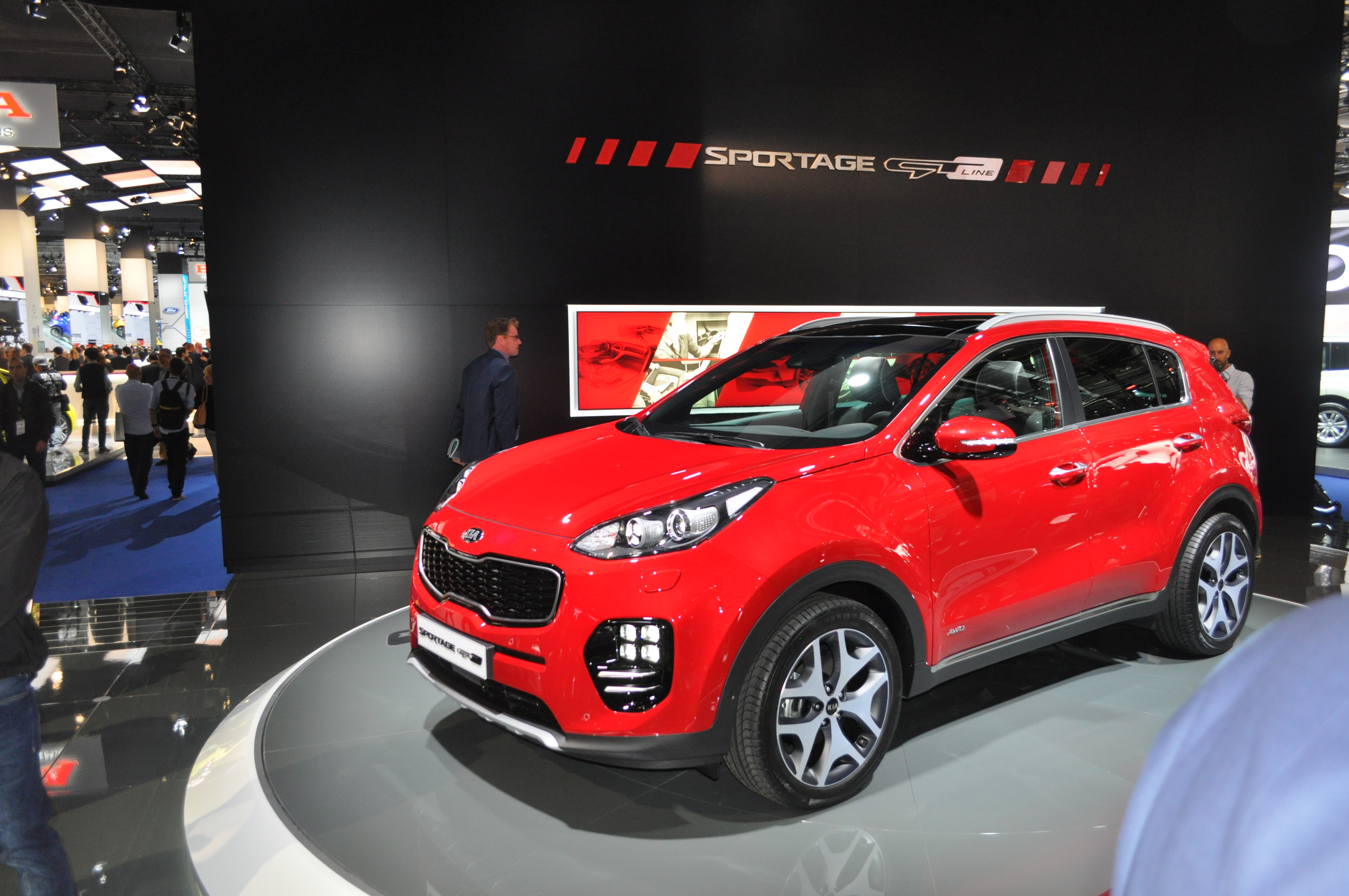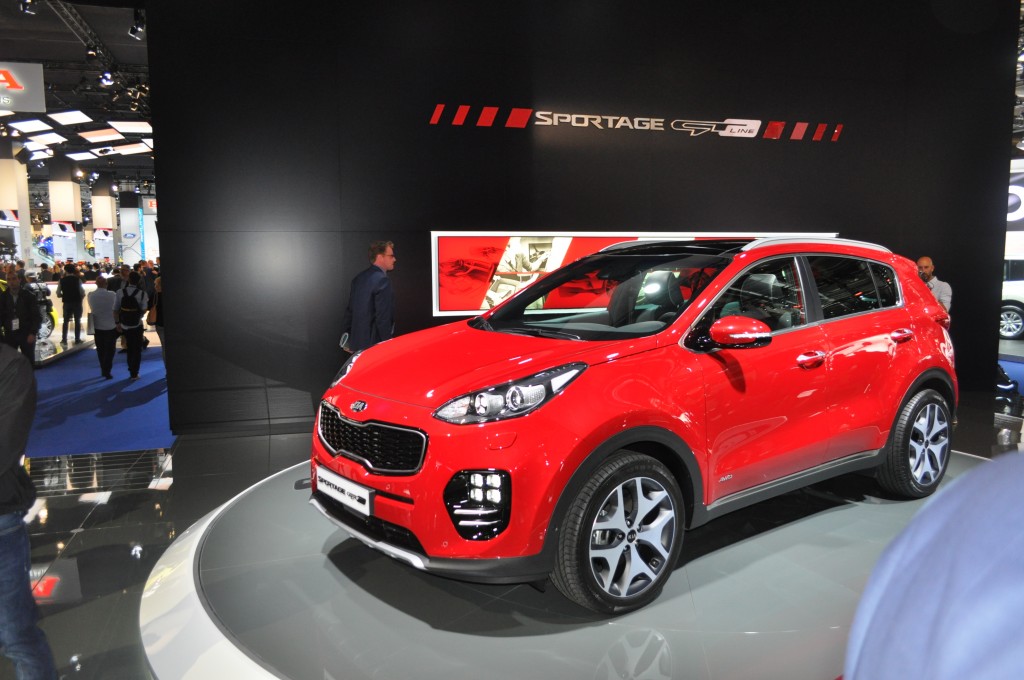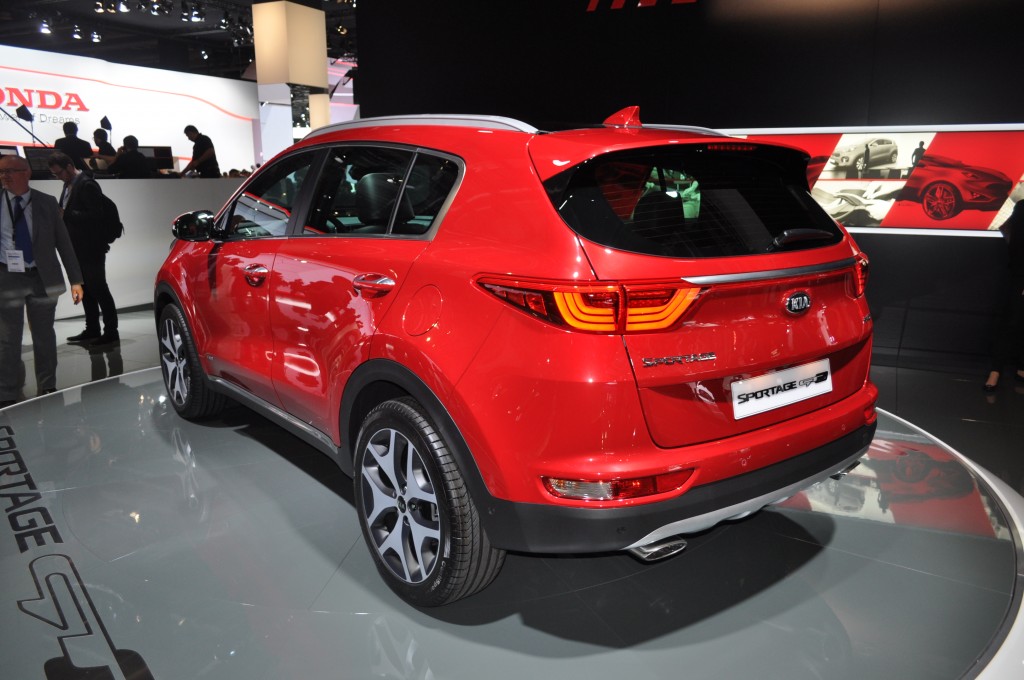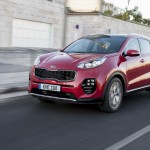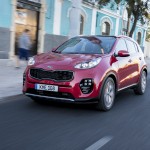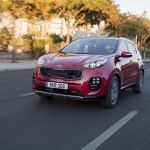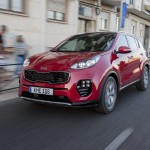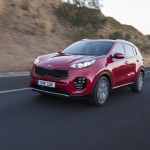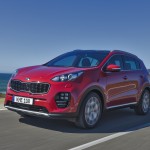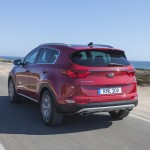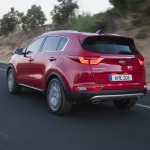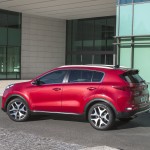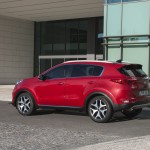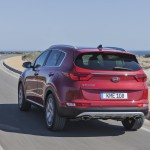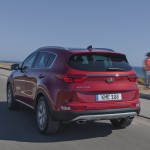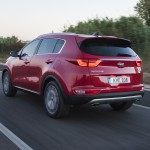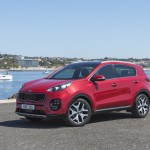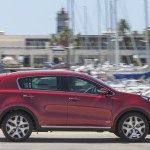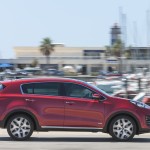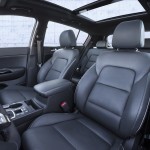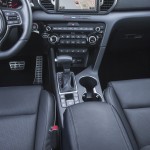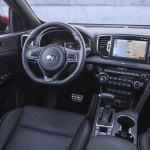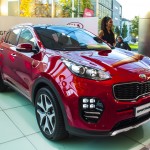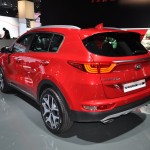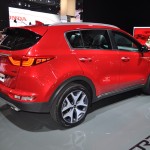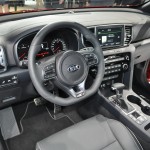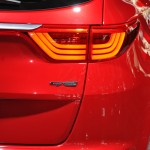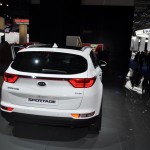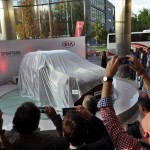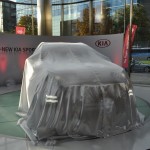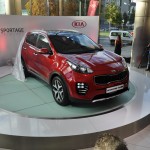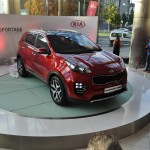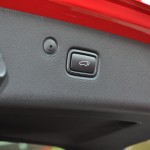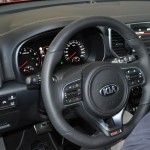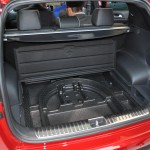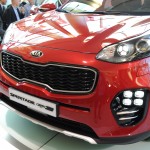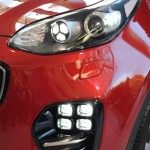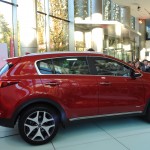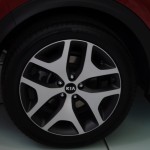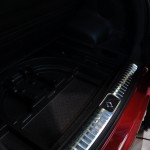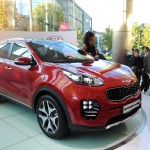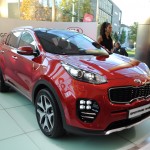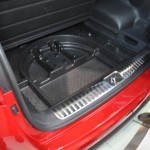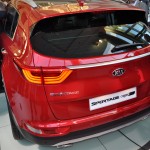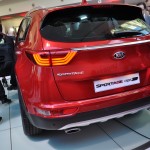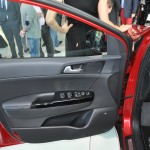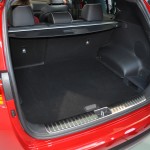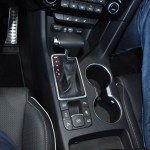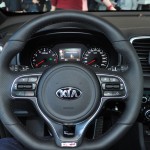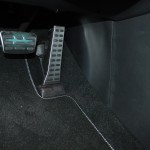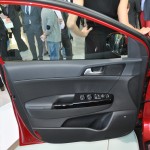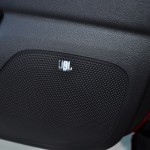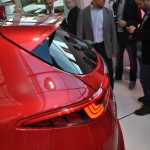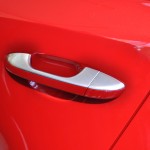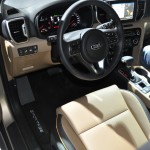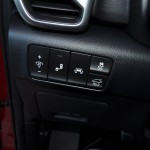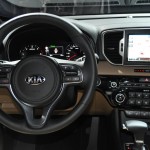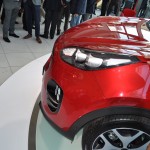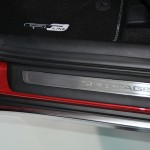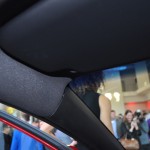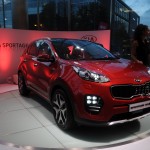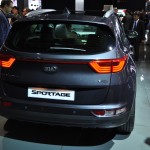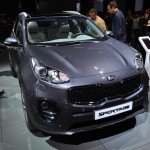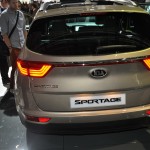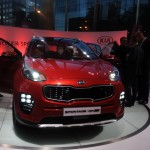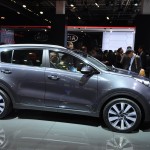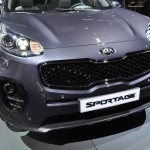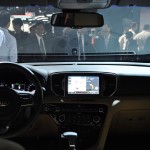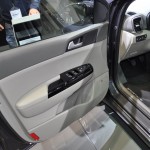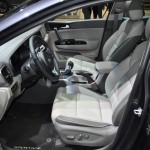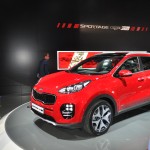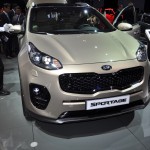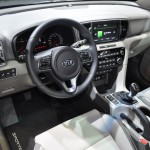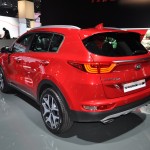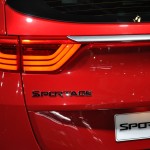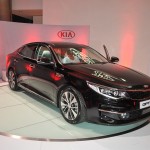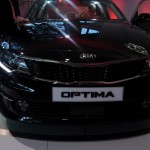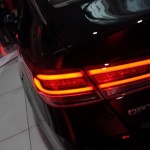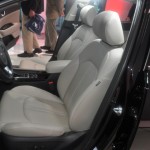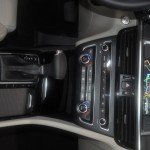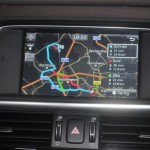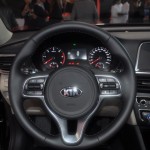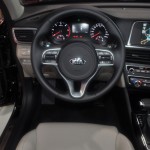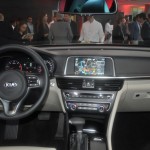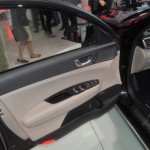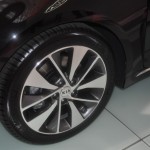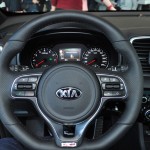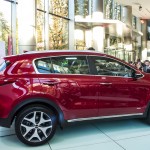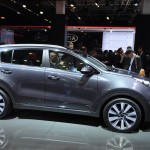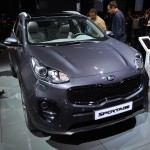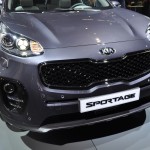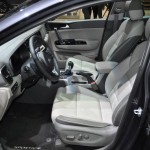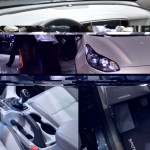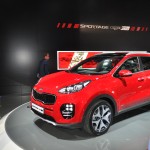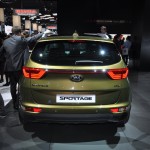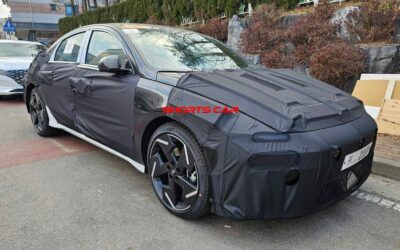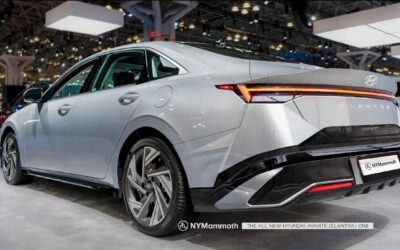During a private event at Kia Headquarters in Frankfurt, the South Korean brand revealed yesterday to the media the all-new Kia Sportage.
[ads id=”0″ style=”float:left;padding:9px;”]What we know so far? With an attractive, all-new interior and exterior design, a host of advanced new technology features and greater quality, the All-New 2016 Kia Sportage is set to be available at the dealers in the first months of 2016 (at least in Europe).
With a choice of revamped gasoline and diesel engines, like the 1.6 T-GDi 175 hp or the availability of Kia’s in house 7-speed dual clutch automatic transmission (DCT), Kia wants to remove that label that says Kia cars have bad driving dynamics, less power or higher consumption compared with its rivals.
I need to recognize that after I saw, touch and take attention to the new Sportage details, the car is beautiful, very high ended, a big step forward for Kia compared to the previous generation. An example of this is, the chromed accents never looks more like a low quality painted plastic, now looks more closer to real aluminium, feels better. And inside Kia used a lot of soft plastics to increase quality feel, as well as they shared from the Sorento a leather dashboard.
About safety, Kia has included the latest technologies like Blind Spot Detection, an automatic city brake system, speed limit information between others, like the use of more than 50% of high strenght steel on the chassis. Also will offer another convenience features such as Smart Trunk or Wireless Charging system for smartphones.
[ads id=”3″ style=”float:left;padding:9px;”]
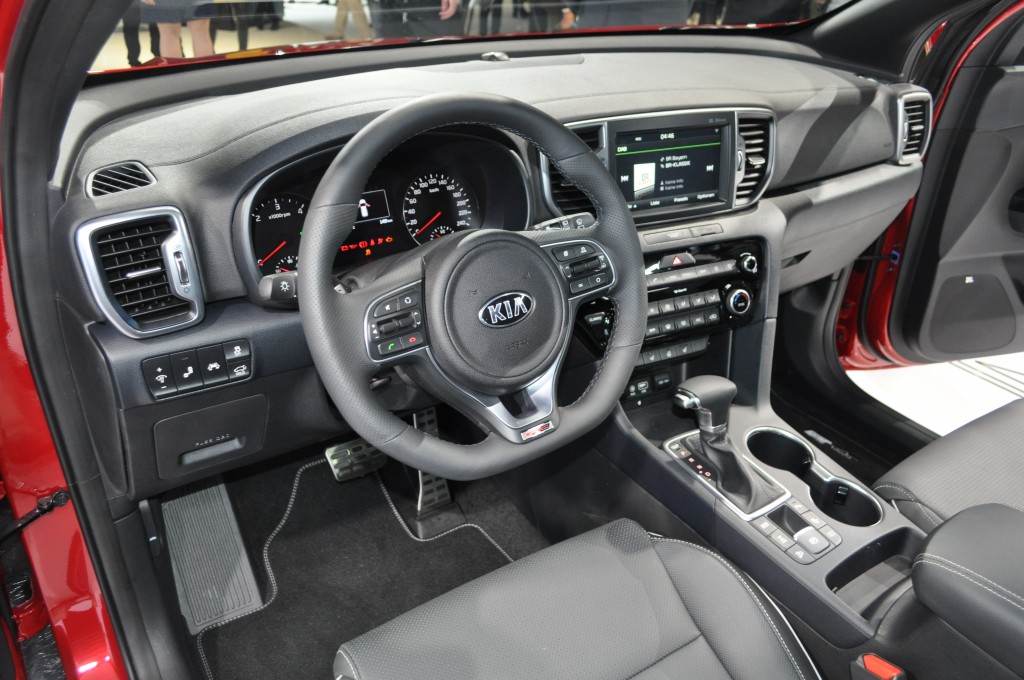
In Europe, Kia also will offer a sporty look for the Sportage with the introduction of the “GT-line” model. This sporty model will be available at launch only with the 1.6 Turbo engine, and will include ice-cube 4 LED lights, dual exhaust pippers, black front fascia, sporty steering wheel or 19″ inch wheels. Looks like Kia finally heard me, and they add 2.0 CRDi 136 and 184 hp avaialble for Sportage GT-line range into the European market.
I will be personally at the launch event this afternoon, 13:30 CET at Frankfurt Motor Show, until that, you can enjoy our first official real life pictures we caught yesterday. Stay tuned!
Press release
Now entering its fourth-generation, the new Kia Sportage compact SUV builds comprehensively on the success of the outgoing model, offering an innovative and sophisticated package to buyers in an increasingly competitive market. The new-look interior features high quality materials and design integrity, as well as great practicality and a range of technologies to improve comfort, convenience, connectivity and safety. A range of new and updated engines and transmissions will result in enhanced efficiency and performance, while ride, handling and refinement are all improved.
For the first time, a new ‘GT Line’ specification is available to Sportage customers. Designed and engineered to appeal to those looking for a sportier driving experience from their Sportage, the GT Line specification delivers all the versatility of the standard Sportage while adding greater visual and dynamic appeal to those customers that desire it.
Michael Cole, Chief Operating Officer, Kia Motors Europe, commented: “The Kia Sportage has helped drive our sustained growth and success across Europe in recent years. It’s an incredibly important car for us, particularly as more customers are turning to SUVs and competition in the rapidly growing compact segment is now fiercer than ever.”
Cole added: “In Europe, the Sportage is Kia’s flagship car, clearly demonstrating our brand values best and consistently accounting for more than a quarter of our European sales. As this hotly-contested segment continues to expand, the new Sportage will reinforce our position among the market leaders, leading the way in terms of its refined innovation, distinctive design and high material quality.”
The Kia Sportage is manufactured at Kia’s production facility in Žilina, Slovakia, and remains the brand’s bestselling model in Europe, with more than 97,000 sold across Europe in 2014, accounting for 27.5% of Kia sales.
Bold new design for 2016 Kia Sportage
The fourth-generation Kia Sportage features a bold new look, with the vehicle’s designers creating a sense of sporty and powerful energy from every angle. The design of the new Sportage has been led by Kia’s European design studio in Frankfurt, Germany, with input from the brand’s Namyang, Korea and Irvine, California design centres.
Echoing the contrast of smooth and sharp shapes found on some of the most iconic modern fighter jets, the Sportage creates visual harmony out of the tension between sharp, defined feature lines and smooth surfacing.
The attractive ‘face’ of the Sportage features the biggest change to the car’s design over the outgoing model, with Kia’s hallmark ‘tiger-nose’ grille and the car’s headlamps separated for the new model. The headlamps are now positioned higher, sweeping back along the outer edges of the sharply-detailed bonnet. A lower, wider grille – enlarged to support greater engine cooling – adds more volume to the lower half of the Sportage’s face. The result is a more imposing appearance and a more stable-looking stance, despite the new model retaining the same 1,855 mm width as its predecessor. GT Line models develop the exterior look further, featuring new ‘ice-cube’ LED fog lamps, inspired by those found on the high-powered cee’d GT, and aluminium-effect skid plates.
The all-new Sportage maintains its highly-recognisable profile, with a 30 mm longer wheelbase (now 2,670 mm), 40 mm greater overall vehicle length (to 4,480 mm) and longer, more aerodynamic rear spoiler resulting in a more swept-back shape. From the highest point of the roof (1,635 mm – unchanged over the outgoing model), the Sportage’s silhouette gently tapers towards the rear of the car, while bolder wheel arches, sharp features lines, and smooth surfacing endow the Sportage with a more dynamic look. The overall effect is inspired by the defined musculature of a sprinter driving out of the starting blocks. Longer front overhangs (up by 20 mm) and shorter rear overhangs (reduced by 10 mm) add to the car’s more raked profile.
At the rear, the new Sportage features more horizontal forms and clearly defined features lines, with smooth bodywork on the tailgate, emphasising the car’s width and giving the compact SUV a more stable appearance. Inspired by the 2013 Kia Provo concept, slim combination lamps running along a horizontal parallel are joined together by a strip that runs the width of the rear, while the turn signals and reversing lights are separate, located lower down to add more visual weight to the lower half. The Kia Sportage GT Line also features dual exhaust mufflers and metal-effect rear underbody diffuser for a sportier appearance.
The attractive new design also makes this the most aerodynamic Sportage to date, with drag reduced from 0.35 to 0.33 Cd – a result of the re-profiled undercover and newly-designed bumper.
The all-new Sportage is available with a choice of 16-, 17- or 19-inch aluminium alloy wheel designs, while the GT Line specification comes with a unique 19-inch wheel option as standard.
Modern layout and greater refinement for high quality new cabin
The Sportage boasts an all-new interior, representing one of the most significant improvements over the third-generation car. The focus for the design team behind the new interior was to create a cabin which offered a wide, driver-oriented dashboard, with a simple, modern design. The interior blends metalwork with soft-touch materials and clearly defined horizontal lines, portraying a high level of mechanical precision.
The Sportage’s all-new cabin boasts a high standard of material quality, with a far greater proportion of soft-touch materials and the use of cloth, leather and stitching creating a more luxurious ambience. The result is an interior that majors on refinement and modern sophistication, with greater soundproofing measures adopted to reduce significantly the intrusion of exterior noise.
Where the cabin of the outgoing Sportage is focused around a clearly-defined central console, with a vertical design, the new model features horizontal lines to emphasise the width of the interior more effectively and generate a greater impression of space and sportiness.
The confident lateral design of the dashboard divides it into two clear zones – ‘display’ and ‘control’. The ‘display’ zone is focused purely on delivering information to occupants in the clearest way possible via the driver’s instrument binnacle and optional new 7.0- or 8.0-inch HMI (human-machine interface) systems in the centre of the dashboard.
Below a clear line running the length of the dashboard is the ‘control’ zone, with the central console cascading downwards and tilted 10 degrees towards the driver. With many functions now found on the optional touchscreen infotainment and navigation system, the new, uncluttered dashboard offers drivers a highly ergonomic layout with the ‘control’ zone’s functions designed to be clearly visible when on the move.
The division between the interior’s two zones also lends itself to single or two-tone colour schemes, with customers able to choose from either a single-tone (black) or two-tone (Dark and Light Grey or Black and Canyon Beige) cabin. The console is finished in black, for a classy, stylish appearance, regardless of the interior colours chosen. Buyers specifying the new GT Line can enjoy a cabin with a slightly sportier feel, with a D-shaped leather steering wheel, high quality piano black fascia and aluminium alloy pedals.
Greater space and improved passenger comfort
The fourth-generation model is set to be the most practical Sportage yet thanks to increased exterior and interior dimensions, with the vehicle’s development teams realising greater space and comfort for all passengers.
The most significant change to the Sportage’s dimensions is a 30 mm growth in its wheelbase, to 2,670 mm, helping to liberate greater space in the cabin. The whole vehicle is 40 mm longer, at 4,480 mm, with the front overhang expanding to 910 mm (+20 mm) and the rear overhang shrinking slightly to 900 mm (-10 mm). The latest model remains the same height (1,635 mm) and width (1,855 mm) as the outgoing Sportage.
Passenger space is increased, with headroom rising to 997 mm (+5 mm) and 993 mm (+16 mm) for front and rear passengers respectively, while maximum legroom has expanded to 1,129 mm (+ 19 mm) and 970 mm (+7 mm).
With passengers able to enjoy extra space, development teams have delivered on a promise to improve comfort even more.
In the front, drivers not only enjoy more legroom, but the seats have been redesigned. The Sportage can now be specified with three-way front heat seating, 10-way power control with lumbar support for the driver’s seat and eight-way power control for the passenger seat. Stiffer seat frames, with greater use of high tensile steel, and redesigned springs and pads – for front and rear – cut the level of vibration in the seats, while reducing seat weight by 2.5 kg and improving durability.
In the rear, a 40 mm lower interior floor – without sacrificing exterior ground clearance – and 30 mm higher rear bench hip point mean second-row passengers benefit from a more natural and comfortable seating posture and improved under-thigh support.
The Sportage’s reclining rear seats now offer 17 steps – from 23 to 37 degrees, with the reclining lever relocated from the upper seat-back to the lower side of the seat to make it easier for rear passengers to get truly comfortable. Rear passengers can also choose from dual-strength seat heating for cushion and back rest – ideal for colder mornings.
For all models, visibility is improved out of the front and rear. Forward visibility is aided by a lowered A-pillar base, while the A-pillar itself has been made thinner. Side mirrors sit slightly lower on the door without impairing the driver’s rear view – this is further aided by the new thinner C-pillars (62 mm thinner compared to the third-generation Sportage) and taller rear glass (+30 mm). Not only do these changes help visibility, they add a greater feeling of air and space to the cabin – enhanced by the 104 mm-longer optional panoramic sunroof opening (now 490 mm).
The new body’s larger dimensions mean cargo space in the fourth-generation Sportage has expanded from 465 litres to 503 litres (VDA), made more practical by a dual-height luggage floor, allowing taller items to fit into the boot and still remain hidden by the tonneau cover. The Sportage also features a new under-floor tonneau cover storage area – unique in the class. Despite the new Sportage being no wider than the outgoing model, by re-engineering the rear section of the body the luggage area is 35 mm wider, while the upper edge of the boot lip is lowered so the lift-over height for heavy items is just 732 mm (down 47 mm).
The all-new Sportage has greater fuel capacity than the third-generation model, with the fuel tank increasing from 58 litres to 62, cutting the number of fuel pump visits that owners of the new car will have to make throughout the lifetime of the vehicle (particularly when combined with all-round improvements to fuel economy).
NVH: All-round improvements to refinement
Key to the comfort of occupants in the new Sportage are the efforts made by Kia engineers to cut noise, vibration and harshness (NVH). Significant changes over the outgoing model render the Sportage one of the most refined cars in its class, with less cabin noise than many other rivals in the C-SUV segment.
At idle, the new Sportage records just 36 decibels when equipped with a gasoline engine (2 dB lower than the outgoing model) and 44 decibels for diesel models (down from 46 dB). The improvements to engine NVH are a result of extensive extra dashboard insulation, as well as new acoustic shields fitted to engines to ensure greater suppression of NVH.
Road noise is further reduced – from 66 to 63 dB – with the adoption of new bushings in the rear suspension to isolate road noise at source, and more sound-absorbent materials throughout the Sportage’s wheel arches. Wind noise is also reduced as a result of thicker front side glass, a new dual lip seal for the panoramic sunroof and additional soundproofing in the doors.
A range of improvements cuts vibrations throughout the car, making the Sportage’s cabin one of the most refined and relaxing among rivals. This has been achieved with all-round improvements to body stiffness, particularly through the floor of the vehicle, as well as the introduction of larger, more absorbent mounts for the transmission, and improved seat design. Alloy wheels that are 49% stiffer also reduce the level of vibration intruding on the interior.
The safest Sportage yet – stronger body and a wealth of active safety systems
Safety, as always, is a top priority for Kia, and the all-new Kia Sportage builds on the brand’s reputation for offering the highest standards in occupant and pedestrian crash safety. The fourth-generation of Kia’s best-seller has been engineered to meet the toughest and most demanding crash safety tests, thanks to an even stronger bodyshell, a wide array of passive safety equipment and the latest active safety and autonomous hazard avoidance technologies.
The structure of the new Sportage is significantly stronger, thanks in large part to the extensive use of ultra-high tensile steel (UHTS) to improve joint stiffness and introduce more effective impact load paths throughout the body. By dramatically strengthening the core structure of the new Sportage, torsional rigidity has been improved by 39% from one generation to the next.
The third-generation Sportage was made up of 18% UHTS, compared to 51% for the body of the new model. The increased use of advanced hot-stamped steel further improves the integrity of the body. The stronger steel has been used in particular to reinforce the A-, B- and C-pillars, side sills, roof structures and wheel arches.
The Sportage is fitted as standard with a large number of airbags, further improving passive safety for occupants, with airbags for driver and front passenger, first row side airbags, and first and second row curtain airbags. ISOFIX child-seat tether and anchor points are fitted as standard to the second row of seats, to safely secure younger passengers.
Pedestrian safety is further improved with a lower leading edge on the bonnet and a larger impact absorption area, which has been revised with greater use of highly-absorbent safety foam and synthetic rubber, further helping to protect pedestrians in the event of a collision. The Sportage is also available with a range of active safety systems to mitigate the chances of a pedestrian collision (see below).
The new Sportage will perform strongly in the Euro NCAP’s important Safety Assist category, which analyses the latest driver assistance technologies and their effectiveness in avoiding accidents and mitigating injuries. Kia’s Vehicle Stability Management (VSM) system, fitted as standard to the fourth-generation car, helps ensure stability under braking and cornering through careful management of the vehicle’s Electronic Stability Control (ESC) and electric motor-driven power steering. Both systems come into play as soon as the Sportage’s many sensors detect a loss of traction, helping the driver to remain safely in control of the vehicle.
Buyers of the new Sportage will be able to choose from the most up-to-date active hazard-avoidance technologies to ensure occupants’ safety at all times – depending on market. Available systems will include:
- Autonomous Emergency Braking (AEB)*, which employs a radar detection system to detect a potential collision with another vehicle or pedestrian and help bring the car to a halt
- Lane Departure Warning System (LDWS), which emits an audible alert when the driver strays from the current lane without indicating
- Lane Keeping Assist System (LKAS), which detects the position of the Sportage in relation to lane markings and takes automatic corrective action if it senses the car starting to draft without the use of indicators
- High Beam Assist (HBA), which automatically adjusts headlamp range according to other vehicles and road conditions
- Speed Limit Information Function (SLIF), displaying the speed limit and overtaking restrictions in the driver’s instrument cluster based on cameras detecting roadside signs
- Blind Spot Detection (BSD) with Lane Change Assist (LCA), which monitors cars up to 70 metres behind the Sportage and provides the driver with a visual warning in the door mirror when another car enters the blind spot
- Rear Cross Traffic Alert (RCTA), which warns against other cars driving behind the Sportage in car parks while reversing.
*The Autonomous Emergency Braking System (AEBS) is an assistance system and does not relieve the driver from his/her responsibility to safely operate the vehicle at any time. The driver still has to adapt his/her driving behavior to his/her personal driving capabilities, to the legal requirements and to the overall road and traffic conditions. AEBS is not designed to drive the vehicle autonomously. For further information, please refer to the owner’s manual.
Smoother, more refined ride and greater handling agility
Throughout the development programme for the all-new Sportage, engineers have aimed to build upon the ride comfort, stability and handling responses offered to drivers by the outgoing car. The new model achieves improvements in all of these areas, and will be the best-handling Sportage yet.
The fully-independent front suspension carries over the format of the outgoing model, but features a range of modifications to make the best use of the new bodyshell. The new setup achieves a leap forward in ride quality, while also delivering sharper handling. Modifications include revised bushing mount positions for greater stability and more natural responses to changing road surfaces, as well as stiffer wheel bearings and bushings resulting in more direct handling and greater stability in all conditions. The steering gearbox is also mounted further forward on the axle for smoother steering inputs.
For the rear suspension – also fully-independent, including the adoption of dual lower-arm multi-link suspension for two-wheel drive models – the new Sportage receives a stiffer cross member to cut road noise and vibrations from intruding into the cabin. Specially-tuned dampers have a longer rebound stroke to eliminate smaller vibrations from poor road surfaces, while the rear subframe is now mounted on isolated bushings to further improve the NVH performance of the suspension. Finally, slight changes to the suspension geometry, as well as stiffer wheel bearings and lateral bushings, quell understeer and allow for more direct handling.
These suspension upgrades, combined with the 40 mm growth in the Sportage’s wheelbase over the outgoing model, provide the all-new model with far superior damping over poor road surfaces, while offering drivers more driving fun through improved handling responses and reduced understeer.
GT Line models receive their own unique suspension characteristics. Tested on European roads with European buyers in mind, the suspension of the GT Line models has been tuned to endow the Sportage with sharper, more athletic handling and a slightly firmer ride, crucially without compromising comfort.
The fourth-generation Sportage is fitted with a new rack-mounted electric motor-driven power steering system (R-MDPS), available as standard on GT Line and optional for all Sportage models across Europe. Mounted directly on the steering rack, rather than on the column, the new R-MDPS provides greater steering feel and quicker, more linear responses to driver inputs – particularly around the centre. When equipped, this upgrade to the steering ensures that the new Sportage sits among the most agile cars in the C-SUV segment, without compromising the ride comfort and stability that consumers expect from a vehicle of this type.
The all-new Sportage boasts greater braking performance compared to the third-generation model, with redesigned calipers and new brake pad return springs reducing braking drag. Combined with larger brake discs, the Sportage offers better stopping power than ever before.
The electronic parking brake in the all-new Sportage has also been upgraded and now switches on automatically when the engine is switched off.
As before, the Sportage continues to be offered with a choice of front- and all-wheel drive, with the revisions to suspension and steering, and the latest electronic driver aids, providing stable handling and high levels of grip in all conditions.
Navigation System with Kia’s Connected Services and wireless phone charging
The all-new Sportage debuts a number of new, advanced on-board technologies to improve the ownership experience for buyers. The new features added to the Sportage make it the most modern, innovative and high-tech car in its class.
Kia’s latest audio-visual navigation (AVN) system introduces a more modern appearance at the centre of the dashboard. Buyers can choose between 7.0- or 8.0-inch touchscreen infotainment and satellite navigation systems, each supporting the addition of DAB digital radio, which is available across a number of European markets.
A new addition is the Navigation System with Kia’s Connected Services, offering a wide range of up-to-date driving-oriented information. Powered by technology company TomTom®, the new connectivity features include live traffic updates*, speed camera locations and alerts*, local search and weather forecasts. In Europe, the system will be available to Sportage buyers free of charge for seven years after the car’s purchase. The Kia Sportage is among the first models in the European compact SUV segment to adopt this advanced technology.
*Legal restrictions to these services may apply depending on country usage
The infotainment system is paired with a 160 watt six-speaker audio system, while music lovers can specify a powerful 320 watt JBL® Sound system, featuring eight speakers, an external amplifier and Clari-FiTM music restoration technology for unrivalled audio quality.
A first for any car in the C-SUV segment, the new Sportage will be available with a new wireless charger for mobile devices, as Kia looks to meet the increasing demand for new convenience technologies from car buyers. Located at the base of the central instrument stack, the wireless charger enables users to charge their phone or tablet without a wire connection, for a cleaner appearance. With ‘foreign object detection’, the 5W charging system activates when a compatible device is placed on the pad, and warns car security-conscious owners when they’ve left a phone on the charger when they leave the vehicle. The system displays the phone’s charging condition on the instrument cluster, and features a safety system to prevent overheating while in use. The Sportage also features up to two USB charging points, one in the front and an optional one in the rear, to allow all occupants to charge their mobile devices while on the move.
Depending on market, other new available features will include: a rear-view parking camera with dynamic parking lines, a Smart Power Tailgate, which opens the tailgate automatically when the key is ‘sensed’ in close proximity to the tailgate; Dynamic Bending Headlamps, which sweep the road ahead in line with the steering wheel for greater visibility and improved safety at night; and a new Smart Welcome function, which turns on interior and door handle lamps and unfolds the door mirrors once the smart key fob is located within 1.3-1.7 metres of the door handle.
New 1.6-litre T-GDI and significantly upgraded 2.0-litre turbodiesel
When developing the new Sportage, a major focus for engineers was realising efficiency and driving performance from the new vehicle’s various power units. Every engine in the range is compliant with the latest Euro 6 emission standard, resulting in cleaner exhaust emissions. This has been achieved, not only without compromising on-road performance, but enhancing it.
As with the outgoing model, the all-new Sportage offers buyers – both private and fleet – a wide choice of gasoline and diesel engines. The fourth-generation model carries over many of the engines found in the current vehicle, and most benefit from a broad range of modifications to improve fuel efficiency, NVH and power delivery. A new 1.6-litre T-GDI (turbo gasoline direct injection) is also available for the first time on the Sportage, exclusively for GT Line buyers, offering a combination of lively performance and high fuel economy to customers looking for a sportier drive.
The range of gasoline engines is made up of a 1.6-litre GDI (gasoline direct injection) engine and the brand’s latest 1.6-litre T-GDI power unit.
The GDI engine, producing 132 ps and 161 Nm torque, is carried over directly from the third-generation Sportage. With the car’s numerous upgrades for the latest model – such as improved aerodynamic efficiency – and the adoption of Kia’s ISG system, this engine promises lower emissions and fuel consumption, pending homologation tests later this year.
The ‘Gamma’ 1.6-litre T-GDI engine is based on the same unit powering the Kia cee’d GT and pro_cee’d GT, offering greater and more emotive engine performance for keener drivers. Available exclusively on the Sportage GT Line, the 1.6-litre T-GDI engine boasts a range of upgrades to ensure it meets owners’ demands for quicker accelerative response, greater fuel efficiency and easier access to engine torque. Producing 177 ps – and peak 265 Nm torque from 1,500-4,500 rpm – the T-GDI engine features a new single-scroll turbocharger with electronic wastegate actuator for quicker engine response and better economy under acceleration.
Further boosting efficiency, the 1.6-litre T-GDI engine receives a new high-energy ignition coil, higher-tumble intake ports, a low-friction timing chain and marginally higher compression ratio (from 9.5:0 in the cee’d GT to 10.0:0 in the new Sportage).
Diesel engines account for the lion’s share of Sportage models sold in Europe, and the new model will continue to offer the 115 ps 1.7-litre CRDi engine – carried over from the third-generation model – and a significantly-upgraded 2.0-litre ‘R’ power unit, establishing a step forward in terms of fuel economy, performance and NVH over the outgoing Sportage and other C-SUV rivals.
The 2.0-litre turbodiesel is available with two power outputs – 136 ps with 373 Nm torque, and 184 ps with 400 Nm – with both benefiting from a 5 kg lighter engine block, up-to-date battery management system, continuously variable displacement oil pump – which senses and modifies oil pressure in real-time – and a new oil filter module.
Lower combustion temperatures in the 2.0-litre ‘R’ engine have reduced NOx emissions to meet strict new emissions standards, aided by a relatively low compression ratio, a new exhaust gas recirculation cooler system, and a new lean NOx trap. A lower-inertia turbine wheel in the turbocharger and electronically-controlled wastegate actuator result in more efficient turbocharging than the ‘R’ engine found in the outgoing Sportage, while stiffer valve springs and high-pressure 2000 bar fuel pump injection allow closer control of combustion within the engine cylinders.
NVH is also dramatically improved for the 2.0-litre diesel, featuring a new heat-resistant engine block cover, a new timing chain cover with integrated acoustic shield, a sound-absorbent cover for the diesel particulate filter, and new intercooler pipe acoustic shield. Mechanical friction is also reduced, further cutting engine noise and improving efficiency, with a new nano-diamond piston coating.
Both high- and lower-powered versions of the 2.0-litre ‘R’ diesel are available both on the standard Sportage and with the GT Line specification.
Sportage available with advanced new seven-speed DCT
The new Sportage features the brand’s all-new seven-speed double-clutch transmission (DCT), recently launched in the enhanced Kia cee’d and available exclusively on models equipped with the new 177 ps 1.6-litre T-GDI engine. Kia’s new DCT is capable of handling the higher torque outputs of the turbocharged engine and offers a sportier driving experience.
Kia’s new DCT has also been developed in-house and has been engineered with low fuel consumption and a sporty driving feel when in manual mode, and with comfort and smoothness when left in automatic mode.
Drivers specifying the new DCT will benefit from faster gear changes than a traditional automatic transmission, as well as lower running costs. When equipped with the new DCT, the 1.6-litre T-GDI engine is expected to return similar carbon dioxide emissions to the manual transmission also available with this engine, pending homologation.
The wider Sportage range continues to be offered with a choice of six-speed manual and automatic transmissions.

